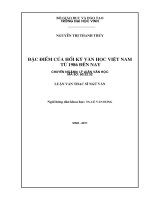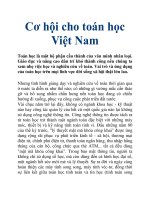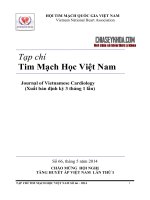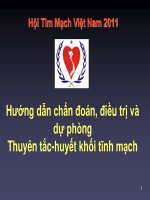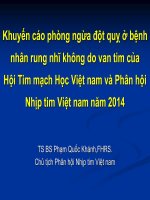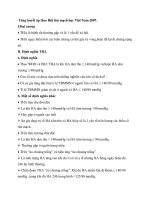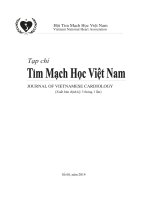Hội Tim mạch học Việt Nam AF HF Mx talk
Bạn đang xem bản rút gọn của tài liệu. Xem và tải ngay bản đầy đủ của tài liệu tại đây (11.22 MB, 63 trang )
Atrial Fibrillation
Management in Heart
Failure patients
Dr Teo Wee Siong
MBBS (S’pore), M Med (Int Med), FAMS, MRCP (UK), FRCP (Edin), FACC, FHRS
Director of Electrophysiology and Pacing
National Heart Centre
Singapore
Mt Elizabeth Hospital
Singapore
Management depends on:
Clinical presentation of AF
New onset, paroxysmal , persistent, long standing persistent,
permanent or unknown
Severity of heart failure esp NYHA Class IV
Underlying heart disease
Severity of atrial dilatation
Treatment of AF in HF
Rate vs Rhythm control
Specific therapies
Drugs
Antiarrhythmic drugs
Drugs for HF /substrate modification
Devices – pacemakers, Atrial defibrillators, ICDs, CRT
Ablation – AV node ablation, AF ablation
Prevention of AF
Upstream therapy - ACE inhibitors, ARB, Statins
Devices – atrial pacing, minimal ventricular pacing
Rate vs Rhythm control for AF in HF pts
AF in HF is a/w higher mortality
Does conversion to sinus rhythm improve survival
Use of antiarrhythmic drugs may worsen outcome
?Role of new drugs for AF and HF
AF in HF is a/w increased mortality
Maintenance of sinus rhythm
improved survival ?
AF-CHF Study - Rhythm Control versus Rate Control for
Atrial Fibrillation and Heart Failure
Kaplan-Meier Estimates of Death from Cardiovascular Causes (Primary Outcome)
In pts with AF and congestive heart failure, a routine strategy of rhythm control does not reduce
the rate of death from cardiovascular causes, as compared with a rate-control strategy
Roy D et al. N Engl J Med 2008;358:2667-2677
? Conversion to sinus rhythm
improves suvival
CHF-STAT
Pts with AF at baseline that converted to SR with
amiodarone showed a significantly better 4 year
survival compared with non-converters (P=0.04)
Deedwania PC, et al.
Spontaneous conversion and maintenance of sinus rhythm by amiodarone in patients with heart failure and atrial fibrillation:
observations from the Veterans Affairs Congestive Heart Failure Survival Trial of Antiarrhythmic Therapy (CHF STAT).
Circulation.1998;98:2574-2579.
Rate vs Rhythm Control
No proven benefit from randomized trials – especially
applicable to older pts with minimal symptoms
Need to individualize
Able to consistently maintain sinus rhythm – outcome
better
Rhythm control may be beneficial in young
symptomatic pts especially when there is suggestion
that the rapid AF causes tachycardia cardiomyopathy
Rate control for AF in HF pts
Rapid irregular rate – hemodyanically unstable, leads to
tachycardia cardiomyopathy and rapid deterioration in
preexisting heart failure
Treatment
Drugs
Non-pharmacological
AV node ablation + CRT
Pacemakers – ventricular rate regularization
Rate controls results in improved LV function
Drugs for rate control
RACE II - Lenient vs strict rate control
614 patients with AF
Persisted for up to 12 months
Followup 3 years
Permanent AF > 80 bpm
lenient
strict
303 pts
311 pts
HR < 110 bpm
(12 lead ECG)
mean achieved heart rate was 93 bpm
97.7% reach HR goal
HR < 80 bpm (12 lead ECG)
and
HR < 110 bpm (at 25% of maximal exercise)
After achieving rate control target: Holter for safety
mean achieved heart rate was 63 bpm
67% reach HR goal
Van Gelder IC et al. N Engl J Med 2010;362:1363-1373
Nonpharmacological rate control
Rhythm control for AF in HF pts
Rhythm control needed for pts who remain
symptomatic despite rate control
Can be done only after exclusion of LA thrombus by
TEE or after initiating anticoagulation
Patient should be in unstable heart failure
Maintainace of sinus rhythm
Amiodarone – most effective drug
Dronedarone provides Rhythm control
Touboul P et al. Eur HJ 2003;24:1481
Singh BN et al. NEJM 2007;357:987
Recent sub group analysis suggest reduction in stroke as well
Hohnloser SH, et al N Engl J Med 2009; 360:668-678
Andromeda
Kober L et al. NEJM 2008;358:2678
Dronedarone in stable HF pts
AF and stable CHF (NYHA Class II and III), dronedarone did
not increase mortality and showed a reduction of CV
hospitalization or death similar to the overall population. A
primary outcome event occurred in 59/114 placebo patients
compared with 42/95 dronedarone patients (HR 0.78, 95% CI
= 0.52–1.16)
However, in the light of the ANDROMEDA study,
dronedarone should be contraindicated in patients with NYHA
class IV or unstable NYHA classes II and III CHF.
Honhloser SH et al. Dronedarone in patients with congestive heart failure: insights from ATHENA
Eur H J 2010;31:1717-1721
Role of specific drug therapies
Antiarrhythmic drugs
Digitalis
Beta blockers
Anticoagulation
Substrate modification drugs
ACE inhibitors
Angiotensin Receptor Blockers
Statins
